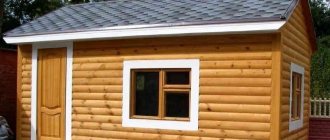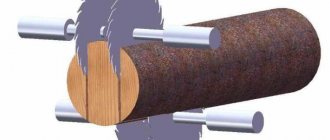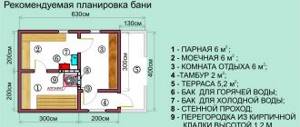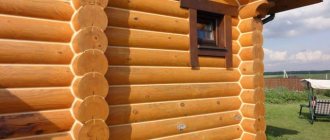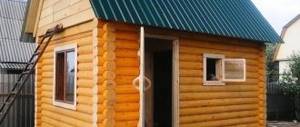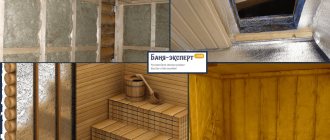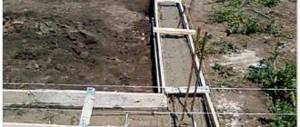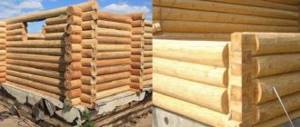Finishing the log house is the final stage of construction. Its task is to arrange the walls, ceiling and floor, and the result is a cozy and beautiful home. Finishing work begins no earlier than 1.5-2 years after the construction of the building. This time is needed for shrinkage. If you do not wait, there is a danger of deformation of the cladding.
Regardless of what materials are chosen for finishing inside the log house, its walls must first be treated with an antiseptic. It is recommended to think through and lay out communications in advance. The choice of finishing materials largely depends on their location.
There are two main types of finishing of a log house: preserving the natural structure or cladding with other materials. The first option is based on using the walls of the house as decoration. The second involves cladding with plasterboard, clapboard, and plastic. In any case, the interior decoration must meet the following requirements:
- be environmentally safe;
- have sufficient strength and wear resistance;
- give the room an attractive look.
The choice of option depends on the preferences of the owner and his financial capabilities. It is interesting that owners of private houses often strive to decorate them as a city apartment, while residents of megacities choose natural materials. Finishing begins after insulation and laying of the subfloor.
Sheathing and finishing of a log house from the inside: choosing the optimal material
Designers working in wooden architecture are conventionally divided into two categories: the first are in favor of leaving log walls in their natural form. The latter consider the natural texture of wood boring and monotonous, and therefore insist on various options for cladding and finishing the inside of the log house:
- leveling the wall profile using a gypsum fiber sheet;
- painting;
- wallpapering;
- clapboard cladding;
- laying ceramic tiles, etc.
Which of them is right is up to the developer to decide. A real, open log is beautiful and aesthetically pleasing in itself. Plus, wood is pleasant to the touch, has a unique resinous smell, soothes and pacifies. Therefore, it is better not to rush into covering the walls. At least for the first few years after construction, you can live in a new house without covering the walls of the rooms with anything. We are talking specifically about finishing materials. The use of protective and glazing agents is mandatory; and these works are not considered finishing work. When building a house from a log, one of its three types is used:
- debarked;
- planed;
- rounded.
The first two are preferred by followers of traditional wooden architecture and connoisseurs of handmade work. “Cylinderization” is chosen by those who love the “ideal” picture. But no matter what the construction log is, it requires mandatory sanding both outside the house and inside. A polished log looks very attractive: smooth, clean, with a clearly defined texture. However, its surface is sanded and polished not only to remove all burrs, burrs and visible flaws in the wood, but also to further protect the material. A forest is a living organism. Not only destructive insects such as the wood-boring beetle, but also various types of fungi, mold, etc. settle on the bark and under the bark of trees. There are also those that continue to develop on cut down, already dead wood. For example, white house mushroom and filmy mushroom. If you do not stop their development immediately after building a house, then in a short time the log house will rot. During sanding, the top layer of wood along with these dangerous pests is carefully removed. This procedure “kills two birds with one stone”: it gives the log a smooth, light surface and extends its service life.
Walls treated with a sanding disc noticeably change the appearance of the room; it becomes truly beautiful. After completing the work, the remaining wood dust is removed from the logs, after which they begin to apply antiseptic, tinting and fire retardant compounds; and, precisely in this sequence. Wall tinting in a log house is most often done in light colors. So the room seems even more sunny and cozy, and the log itself gives a feeling of real Russian “homeliness”. To tell the truth, not everyone likes walls with such a pronounced relief, so they are often subjected to additional finishing. Guides are nailed on top of the logs and wall material is installed on them, creating a perfectly smooth surface, for example, plasterboard. Drywall sheets are the basis for further wall decoration - painting or wallpapering. The best option for a wooden house is fire-resistant gypsum board grades. The technology for painting a plasterboard wall is as follows:
- seal the joints of adjacent sheets using reinforcing tape and putty;
- cover the surface of the walls with gypsum putty;
- polish;
- primed twice;
- complete surface preparation with finishing putty;
- Using a short-haired roller, apply paint of the selected shade in 2-3 layers.
It is worth recalling that the paint should be environmentally friendly and friendly to the health of the inhabitants of a wooden house. For lovers of designs and patterns, wall decoration with wallpaper is more suitable. Their choice is endless, so you can always choose a color, texture and ornament that matches the taste of the owner and the style of the living space. Preparing drywall for gluing is exactly the same as for painting. Old wallpaper should be removed with special care so as not to damage the gypsum board base. It is customary to moisten worn-out wallpaper with very hot water. You need to remove strips of old wallpaper quickly, but not with sharp, but with careful and smooth movements. With this approach, the cardboard underneath will remain intact. Another popular option for leveling log walls is to “camouflage” them using wooden lining. The golden color of the “slats” seems to add sunlight to the house. If the lining is installed vertically, it will visually raise the ceiling, if horizontally, it will move the walls apart. Lining is a favorite material among the people. Its distinctive characteristics:
- versatility in application;
- decent appearance;
- simple, understandable installation technology;
- wide selection of original wood species;
- harmless to health;
- affordable price (classes “Extra” and “A” are more expensive, “B” and “C” are cheaper).
Frankly speaking, the desire to hide logs under the clapboard is difficult to explain and illogical. It leads to considerable additional costs: for materials, for installation work, for the purchase of protective impregnations and paints and varnishes, etc.
If someone does not like the round profile of the log, you can build a house from rectangular timber, which does not require leveling the walls. However, everyone sees their dream home in their own way and builds it according to their own scenario.
Decorating a house in a rustic style
Jute rope for finishing
One of the options for decorating the interior walls of a bathhouse is to use regular or jute rope. This method of finishing with jute is acceptable for buildings built using the “bowl” technology. For log houses constructed using a different method, it is better to choose an alternative finishing method.
Work begins after the internal surfaces of the premises are completely treated with an antiseptic and sanded. For this work, it is recommended to purchase a special decorative rope; its cost is not that high. It fits only into crowns, fulfilling two roles at once - protective and decorative. The rope can provide insulation, protection from moisture and wind.
The floor is made of wood; it is best to use a solid board, which, after installation, is impregnated with special oil or varnished. For the ceiling, it is recommended to use wooden paneling that is maximally protected from moisture. It is best to begin finishing work when the log house has settled and the logs have dried out a little. This happens about a year after the building is completely ready. The rope in the crowns is attached in different ways; most often, special nails are used that have plastic heads. You can use staples and glue. Before laying, the rope should be thoroughly treated with an antiseptic.
Before laying, the rope is measured to the required length and then cut. You must be careful not to fray the edges. To do this, they are first wrapped with threads, after which they are covered with a layer of varnish or glue. At the starting point of fastening, glue is always used, which makes the fixation as reliable as possible. It is best to do this from the bottom corner, covering the area with a thin layer of adhesive. The adhesive composition is applied with a hot-melt gun; regular glue cannot be used.
Staples and nails can be used as additional fixation; this method will be the best and most reliable.
The rope is laid on the adhesive layer, after which it is fixed with nails every 15-20 cm. When the design of all the crowns and joints of the bathhouse frame is completed, it is necessary to cover the frame wall and the rope with a layer of protective varnish.
Article on the topic: Roto door: features of the mechanism and review of the original roto fittings
The interior decoration of a log bathhouse is not as complicated as it might seem. In many cases, the simplest materials are used; only surface varnishing can be done. This happens due to the fact that the natural logs from which the walls are made are attractive in themselves; they do not require mandatory finishing. For work, you can use various materials, but remember that not all are suitable for a bath, but only those that are resistant to high humidity and temperature changes in the room.
Decoration of electrical work - remember the wiring of the 50s of the last century
Retro style is in fashion now. Post-war Soviet films, clothing models of those years, and household items are again popular. The half-forgotten style of the last century is returning to our everyday life. This is especially noticeable in the design of fashionable interiors. Furniture in the style of the 50-60s of the 20th century is increasingly used, and antiques are of increasing interest. Some owners of wooden houses, adherents of retro, went even further. For example, they lay electrical wiring the way it was done before - with twisted wires, on porcelain insulators, in the public domain. This method of laying, in addition to being original, also has undoubted practicality:
- simple installation method;
- convenience for monitoring the wiring condition;
- simplifying repairs.
A more modern way of attaching electrical wires (but still with a hint of retro style) is to use plastic boxes, corrugated pipes, and Euro baseboards. In these cases, the wiring is also located in plain sight, but the wires themselves are hidden in cable ducts. It looks neat, aesthetically pleasing and safer. Retro wiring gives the interior a “zest” and individuality - especially if other things, furniture, textiles, and lamps correspond to this style. In a log house, such an interior does not look out of place at all.
The task of external cladding of a wooden house
The facade of a wooden house cannot be left without protection, otherwise the material will simply lose its appearance or suffer from the destructive actions of rodents and insects.
Cladding of a wooden house is carried out to solve the following problems:
- increase resistance to rodents, insects and fire;
- improve the appearance of the structure;
- protect the structure from heat loss;
- increases the sound insulation of the building.
The materials used for cladding the building must meet certain requirements:
- minimum level of moisture absorption and hygroscopicity, this helps prevent the process of wood rotting;
- the material must allow air to pass through and remove excess steam inside the structure; these requirements directly affect the internal microclimate and atmosphere of the house;
- the thermal conductivity of the material should be minimal, this will retain heat inside the building and significantly reduce heating costs;
- the product must have high fire resistance; in the event of a fire, the fire will be minimized;
- have high resistance to chemical aggressive substances;
- be highly resistant to bacteria, insects, mold and mildew;
- the material must be environmentally friendly;
- sound insulation, i.e. Products must contain noise.
Design styles: choose an economical option without sacrificing quality
Meanwhile, the “Russian hut” style is not the only one suitable for decorating a log house. Virtuosos of wooden architecture - Scandinavian architects and builders - contributed to the popularity of their national style far beyond the borders of their own countries. Scandinavian interior design, which is fashionable these days, is distinguished by its light appearance, ergonomics, a certain modesty and elegant simplicity. The chic of this style is bleached wood, pastel colors, clear geometry of furniture and reasonable functionality of each piece of furniture. Any homeowner can equip their home in a Scandinavian style on a budget; It is not necessary to equip your premises with things from IKEA - after all, many things can be made with your own hands - tables, racks, shelves. As a rule, they do not have complex shapes, but benefit from correctly selected colors and original decorative elements. The materials used in the decoration of Finnish and Swedish houses are always natural, environmentally friendly, and mainly of local origin. We have all this too. Therefore, the style of decorating a wooden estate, which came to Russia from Scandinavia, has taken root in our open spaces. This is truly a beautiful and economical option, without sacrificing quality.
The fashionable “shabby chic” trend also looks organic in a wooden house. Its characteristic feature is the combination of deliberately aged furniture and modern technological advances. This style bears a pronounced imprint of the individuality of the owner of the house. Each item bears a mark left (or seemingly left) by the older generation of his family. An interior in the “shabby chic” style is always unique and unique. It is distinguished by an abundance of white, the presence of scuffs and chips on drawers and cabinet doors, pastel soft colors of textiles, as well as a lot of decorative little things. All this can be created at home without attracting large financial resources. Other design solutions are also suitable for log houses: country, Provence, classicism, modern, minimalism, chalet. Some people like the interiors of a hunting house, with rough finishing of the walls and fireplace with natural stone, with thick carpets on the floor, with an abundance of stuffed animals and weapons hung on the walls. This style is out of fashion: it was and is loved always and everywhere. He has many fans and even female fans. It’s probably possible to inexpensively equip your house in a hunting style, but only on the condition that you are an avid hunter and are ready to “assemble” your interior bit by bit: gradually, and for more than one year. In all other cases, this is a very expensive option, and not everyone can create it in full.
Bathhouse made of laminated veneer lumber. Interior decoration and communications
Our website presents a number of log house projects, for example: Or you can see all prices for log houses. You can calculate the house or bathhouse you need with maximum accuracy using our log house cost calculator. To order and buy a log house, call:
- Vologda
- Moscow,
Comments
No comments yet.
Sanding and sanding
Sanding of logs is carried out before laying them in the log house and cutting out the joining grooves. It involves stripping the outer bark of a tree down to bare wood.
A scraper, an ordinary bayonet shovel or other available tool is taken, and the subbark layer and bark, which serve to protect the wood from external influences in natural conditions, are scraped off from the trunks intended for construction.
In order to enhance the protection of logs used to build a house from external influences (moisture, mold, fungus, insects, ultraviolet radiation), all of them are additionally processed and sanded before being laid in the log house. Often houses are built from purchased timber that has already undergone such processing.
Log house before sanding and polishing
Sanding, in addition to its protective function, also significantly improves the external characteristics of the wood - it gives it a natural, original color. For subsequent application of coatings such as varnish, this procedure is literally necessary.
Grinding is carried out with special tools such as a grinder or grinder, equipped with fine abrasive discs or attachments with “sandpaper”.
Covering the bathhouse with plastic panels
To quickly and cheaply cover a frame bathhouse, you can use decorative plastic panels. The plastic facade has an attractive appearance, and its performance characteristics are not inferior to siding.
Plastic panels have the following advantages:
- low cost;
- wide choice of colors;
- resistance to corrosion and rotting;
- low hygroscopicity;
- no need for additional treatment with antiseptics;
- frost resistance;
- practicality and wear resistance;
- accessible and easy installation;
- simple maintenance.
Despite the positive aspects, such material is not without its disadvantages:
- low air permeability;
- susceptibility to mechanical damage, deformation and fading;
- high flammability.
Plastic panels are mounted on a pre-installed slatted frame. Before starting work, the surface of the bathhouse is carefully treated with compounds to protect against fire and rotting.
Tags: sheathing, outside, log house
« Previous entry
Covering a bathhouse with a block house
It is a type of imitation wood whose outer side is rounded. The factory technology for drying block house panels provides a standard humidity of 12%.
Advantages of a block house for external cladding:
- environmental friendliness and naturalness;
- attractive appearance;
- affordable price;
- simple and easy installation;
- convenient sizes.
There are practically no negative aspects to such coverage. In some cases, they are associated with a violation of installation technology or low quality wood that was used for its production.
The panels are installed on a pre-prepared wooden frame at a minimum distance from each other of 65 cm. Fixation is carried out from the foundation to the roof using self-tapping screws. The finished coating is sanded and treated with protective varnishes or paints.
Internal insulation
We have dealt with external insulation, now we will look at how and with what to insulate a log house from the inside, starting with the walls. So, for these purposes you need to prepare the following materials:
- insulation – as for external insulation, mineral mats are the best choice;
- slats with a cross section of 20x20 mm;
- boards;
- vapor barrier film;
- material for wall finishing - lining, plasterboard, etc.
Thermal insulation of walls from the inside
It must be said that this technology resembles the installation of a curtain facade, however, it contains its own nuances:
- before insulating the walls from the inside, they also need to be caulked and treated with an antiseptic compound;
- slats are placed on the prepared wall. As a rule, they are arranged in horizontal lines in increments of a meter and a half;
- then a vapor barrier film is attached to the slats. The vapor barrier must be stretched so that an air gap is formed between it and the wall. To fasten it, a construction stapler is usually used;
- then vertical posts are attached to the slats according to the same principle as installing the frame on external walls;
- Mineral mats are laid in the space between the racks. If they fit tightly, then they do not need to be fixed with dowels;
- then a vapor barrier film is attached over the racks;
- At the end of the work, the frame is sheathed with clapboard or other material.
This completes the insulation of the log house walls from the inside.
Thermal insulation of the ceiling from the inside
Ceiling
Finally, I will tell you how to insulate the ceiling from the inside. For this you will need the same set of materials as for floor insulation. The operation is performed like this:
- work begins with dismantling the ceiling lining and sheathing;
- then a vapor barrier film is attached to the floor beams and boards located in the attic;
- then mineral mats are laid in the space between the beams. They can be secured with slats;
- then a vapor barrier film is attached to the slats;
- At the end of the work, the ceiling is sheathed with clapboard, plasterboard or other material.
Here, in fact, is all the information about how and with what to insulate a log house inside.
